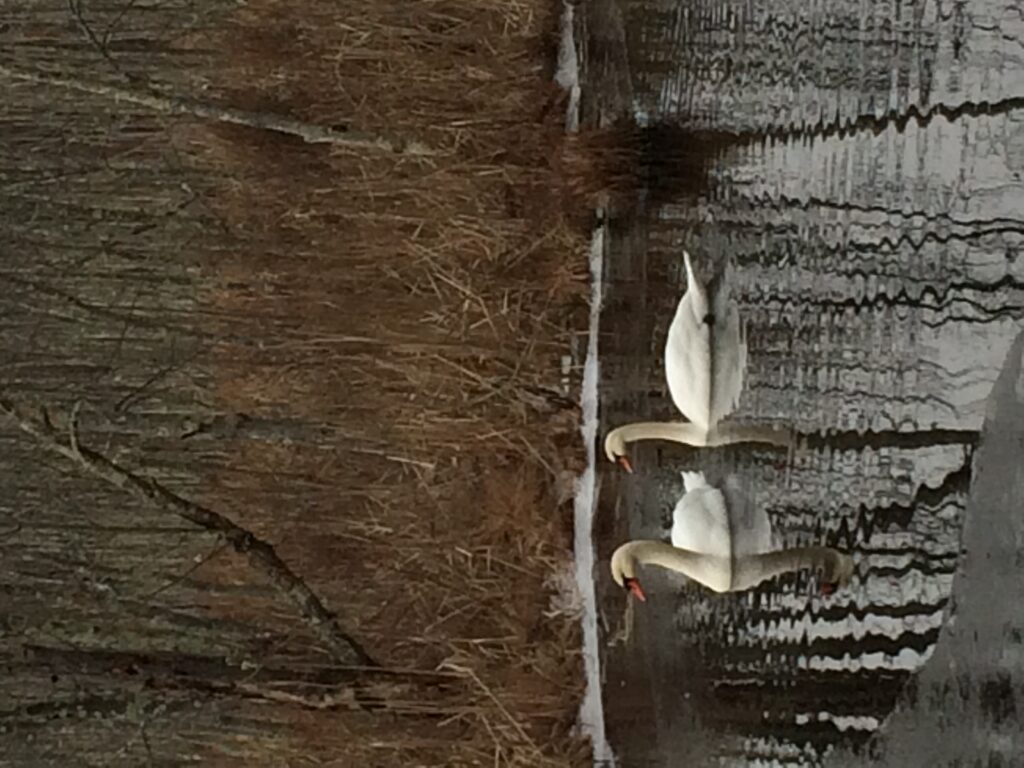The tundra swans that breed in the western arctic migrate thousands of miles to our west coast, gracing the skies and waters of California and scattered inland regions of Montana, Idaho and Utah. Close to two hundred of them were counted gliding on the Bear River wetlands near the Great Salt Lake last week. Other times, counts are in the thousands. The populations that breed in the eastern arctic travel to the Great Lakes and, mostly, the midAtlantic coast, some stopping over at the Harriet Tubman Underground Railroad National Park in Maryland these days, and are iconic on the Chesapeake Bay.
Our other native swan, the larger trumpeter, far more local, was brought back from the brink of extinction beginning in the early 1900s, when, after three centuries of overhunting, only a few dozen remained. Damage to muskrat and beaver populations also affected swan populations who nest on their dams and dens, and as these industrious rodents recovered, swan habitats improved as well.
There is another swan in the United States, the mute swan, introduced in the late 1800s largely as an ornament on wealthy estates. With few natural predators, and impressive survival agility, mute swan populations have grown, and in some coastal regions nesting species may have reached carrying capacity. Hudsonia, the small ecological research institute I work with, recently put together a round-up of current knowledge to help inform the ongoing debate on how to handle this charismatic, but potentially problematic, species, excerpted here.
As is often the case with introduced species, impacts of mute swans may be assumed rather than documented, raising the possibility that these birds are the subject of an ecological narrative, to borrow Robert Shiller’s well detailed economic narratives, those partial truths we repeat sometimes without much of a fact check. Sometimes those narratives are amusing, sometimes annoying, but in fact they drive policy decisions often with poor outcomes. Managing swan populations either by addling eggs or culling the birds themselves is an expensive long-term commitment, with no guarantee of success. Our conservation resources are limited.
Mute swans are accused of harassing other nesting waterbirds, depleting aquatic vegetation, attacking humans, and polluting bodies of water. Sometimes they are guilty as charged. And they aggressively defend their nests, as do our native swans who fend off many predators, including foxes. In the popular press, a mute swan defending his nest may come across as aggressive, a tundra swan, valiant.
And, like most birds, they eat a lot. Some ecologists and hunters are concerned that their habit of uprooting more than they eat could deplete submergent aquatic vegetation (SAV), the nursery grounds of fish and crustaceans, thereby reducing duck populations. And on their loafing sites, funny concept, apparently they have inadvertently trampled the nests of rare shorebirds. However, to Hudsonia’s knowledge there have been no species-specific studies of other birds’ nesting success in the presence of mute swans, and most aggression is directed toward also burgeoning year-round populations of Canada geese. Other than isolated accounts, there is “no evidence to support nesting disruption of marsh-nesting birds.”
The primary factor in the widespread declines in SAV beds, documented in coastal, estuarine and lacustrine habitats around the world, is reduced water clarity caused by inorganic sediment, nutrient additions, and eutrophication. For example, sediment that comes into the Hudson River during heavy rains persists for years and even decades, resuspended by recurrent rain storms. Exposed agricultural soils, point sources like treatment plants, and impermeable urban and residential surfaces all contribute, their effects tending to be exacerbated by the warming effects of climate change. There is evidence that animal herbivory is more damaging in areas already over-stressed by those effects.
We already have developed methods to improve water quality ready at hand, identified by the science as the driving factor in restoring and preserving SAV beds, and such projects create entry-level jobs in science and conservation work, sectors that look weak in Bureau of Labor Statistics’ projections. Managing runoff would potentially be of greater value than managing mute swans on many levels.
Focusing on one introduced species, here mute swans, also detracts attention from coming up with integrated solutions that treat the many stressors, including alien species, as part of a web to be rewoven as best we can.
Photograph of mute swans in New York, P. Dunne




